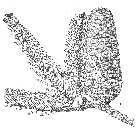Chinese stamp honoring A. beshanzuensis. Stamp designed by Zeng Xiaolian and issued 1992.03.10.

Line drawing; for full size image go to the Flora of China (Fu et al. 1999).
Chinese stamp honoring A. beshanzuensis. Stamp designed by Zeng Xiaolian and issued 1992.03.10.

Line drawing; for full size image go to the Flora of China (Fu et al. 1999).
Abies beshanzuensis
百山祖冷杉 bai shan zu leng shan [Chinese] (Fu et al. 1999), Baishan fir (Farjon 1990).
Has been placed in synonymy with A. delavayi but is here treated as a distinct species, both geographically and morphologically distinct from several other similar firs: A. firma, A. fabri, A. kawakamii and A. homolepis. Of these, it is perhaps most similar to A. firma and is accordingly placed in Section Momi, subsect. Firmae (Farjon 1990).
Trees, up to 30 m tall and 80 cm dbh (but in 1987 no wild trees were larger than 15 m and 25 cm dbh [Dudley 1988]), with a straight round trunk and long, horizontally spreading branches. Bark smooth and light grey on young trees, later becoming scaly and longitudinally fissured. Branchlets stout, initially light yellow or brown-yellow, sometimes turning gray-black in 3rd or 4th year, glabrous or puberulent, with circular or ovate leaf scars. Vegetative buds ovoid to conical, resinous; bud scales light yellow-brown, triangular-ovate, slightly keeled. Leaves shining dark green above, paler below, spirally arranged, ascending on upper side of main branchlets, pectinately arranged in 2 lateral sets on lower side and on lateral branchlets, linear, unequal, (1-)1.5-3.5(-4.2) cm × 2.5-3.5 mm, twisted at base, ligulate-linear or oblanceolate, flattened, with a notched apex; stomata absent on upper surface, in 2 white bands below, resin canals 2, marginal. Pollen cones lateral, in leaf axils, 2-2.5 cm long, yellow with red microsporophylls. Seed cones lateral, erect, brown-yellow or light brown at maturity, cylindric, 7-11 × 3.5-4.5 cm. Seed scales at middle of cones flabellate, rarely reniform, 1.8-2.4 × 2.5-3 cm, base auriculate, surface striate, margin erose-denticulate laterally. Bracts constricted at middle, distal part spatulate, orbicular, or truncate, 2-2.5 cm long, apex cuspidate, cusp exserted ca. 1 mm, reflexed, acute. Seeds: oblong-obovate, 6-9 × 3-4 mm, with a cuneate or dolabriform wing; 13-19 mm long including wing. Pollination May, seed maturity October to November (Farjon 1990, Fu et al. 1999).
China: SW Zhejiang, at about 1700 m elevation (type from Qingyuan: Baishanzu Shan) (Fu et al. 1999). It is extremely rare, with only 3 known individuals in the wild as of 1988. The population at discovery in 1963 consisted of only 7 individuals, of which 3 were removed to the Beijing Botanic Gardens and subsequently died there. The type locality is a single grove at 1500-1700 m elevation on Baishanzu (elev. 1857 m) in the Tung-Kung Range, NE of Qingyuan (27° 45' N, 119° 11' E). The maritime climate features warm summers and cool, moist winters (precipitation ca. 1250 mm). The species occurs in a mixed stand with broad-leaved trees such as Castanopsis spp., Fagus lucida, Quercus spp., Acer spp., Magnolia cylindrica and Lithocarpus hancei; and a few conifers, including Cryptomeria japonica var. sinensis, Tsuga chinensis, Cephalotaxus sinensis and Taxus sumatrana (Farjon 1990).
Hardy to Zone 6 (cold hardiness limit between -23.2°C and -17.8°C) (Bannister and Neuner 2001).
The oldest reported living tree was 226 years old (crossdated) in 2012 (Liu et al. 2019, citing Cao et al. 2012).
No data as of 2023.02.22.
No data as of 2023.02.22.
"Efforts of replanting with grafted stock (on A. firma) seem to be successful at its original locality and on nearby sites" (Farjon 1990).
Cao S., Cao F., and Xiang W. 2012. Tree-ring-based reconstruction of temperature variations from May to July since 1840 in Yanling county of Hunan province, China. J Central South Univ Forestry Technol 32:10–14.
Dudley, T.R. 1988. Chinese firs: particularly Abies beshanzuensis. American Conifer Society Bulletin 5(4):84-93.
Farjon, Aljos. 1990. Pinaceae: drawings and descriptions of the genera Abies, Cedrus, Pseudolarix, Keteleeria, Nothotsuga, Tsuga, Cathaya, Pseudotsuga, Larix and Picea. Königstein: Koeltz Scientific Books.
Liu, Jiajia, Bao Yang, and David B Lindenmayer. 2019. The oldest trees in China and where to find them. Frontiers in Ecology and the Environment 17(6): 319–22. https://doi.org/10.1002/fee.2046.
Wu Ming Hsiang. 1976. Abies beshanzuensis. Acta Phytotaxonomica Sinica 14(2):16.
Zeng Xiaolian. Stamp, issued 1992.03.10. http://www.bupt.edu.cn/stamp/plant/92_3.htm, accessed 1999.04.12, now defunct.
The species account at Threatened Conifers of the World.
Last Modified 2023-10-31